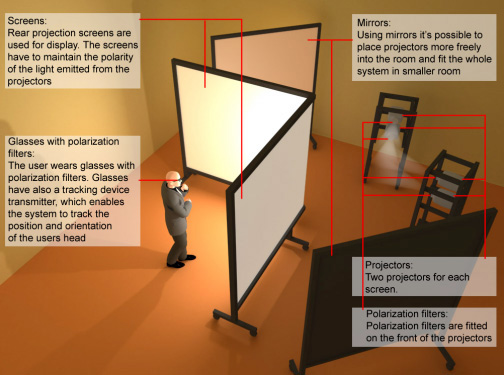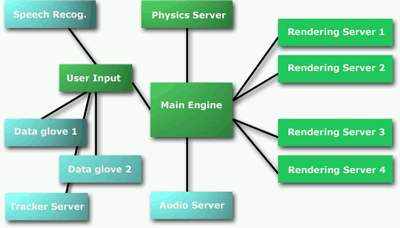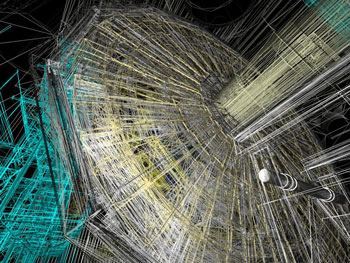|
|||||||
Game Technology in Virtual Reality Developmentby Jukka Rönkkö VTT Information Technology, Product Information Management group has built a virtual reality platform based on game engine technology and off-the-shelf PC hardware. Game technology can be beneficial in developing tools for constructing virtual-reality applications. For example, game engines can offer software technology for efficient 3D real-time rendering on off-the-shelf PCs. The pipeline from 3D-content creation tools to virtual reality has also traditionally been problematic. However some game engines offer plug-ins for commonly used 3D-modelling packages as well as other tools to help with content production for 3D. Taking advantage of recent developments in game technology within the context of virtual reality is therefore an interesting possibility. In recent years, the advances in PC graphics hardware and game software have been remarkable. Games have pushed the need for quality 3D graphics into the mainstream. As the games market has grown to overtake the film industry in revenue, so has the demand increased for tools that will speed up the development and content production. This has led both to in-house custom solutions, and to more generic game-engine-approach, middleware solutions that provide connectivity between commonly used 3D-modelling tools and the game platform. These platforms also include software libraries for game development. Sometimes game engines have been designed specifically for certain types of games (eg indoor or outdoor), or impose other requirements on the content that can be used. Some solutions hide the details of graphics rendering to such a degree that it is not possible, for example, to programmatically interfere with the perspective projection calculations. However, if the possible limitations are kept in mind and appropriate tools are selected, it is possible to use game technology to construct quite useful and general-purpose virtual reality systems.
Within the soon-to-be-completed View of the Future EU project, we have developed a scalable virtual-environment software platform running on the Windows XP operating system, on ordinary PCs equipped with graphics cards suitable for 3D game play. The system has mainly been used to run the VTT Lumeportti system, which has two rear-projection screens and five 2.0GHz Pentium 4 PCs with GeForce4 128MB graphics cards. The platform makes possible the use of various input technologies, including position and orientation tracking, data-glove input with basic gesture recognition, space-mouse input and speech recognition. Feedback to the user is provided via stereoscopic real-time graphics, and audio. The system utilises passive stereo, that is, two projectors project the image for each wall. The image is separated for each eye by using polarisation filters in front of the projector lenses and by polarisation glasses for the users. It is intended that the system will act as a test bed for different technologies as well as enabling us to develop applications for real needs. The structure is modular in the sense that the main functionalities of the system - for example rendering - are located behind a well-defined software interface and can be run as a separate process. In this way it is possible to change the implementation of different components without affecting other parts of the system. Our software platform acts like glue between different components and orchestrates various actions over the network - like rendering - that take place in different computers. Due to the flexibility of the system, we have been able to test various game engines as rendering components. According to our experiences, some engines excel in raw triangles-per-second performance better than others and some offer more refined visual features, such as finer material definitions and shadows. Both of these types of engines have their optimal field of usage; for instance, a lot of raw polygon performance is good for CAD visualisation, while fine visual features are required by architectural visualisation applications. Our experiences also show that not all game platforms are suitable for the virtual-reality cluster-type rendering approach, and a certain amount of flexibility and access to the internals of the engine may be required.
We have used our system in the fields of architectural and CAD visualisation, as well as for training. As an example we built a visualisation application for the demands of the ATLAS project in CERN. ATLAS is a detector station in a new particle accelerator known as LHC (Large Hadron Collider). ATLAS is an example of a vastly complex construction project, as the detector is the size of a five-storey building. Our tool is valuable for clear communication during the construction process. It is used to visualise the CAD-originated detector parts and discuss different assembly options. The application utilises a space mouse for navigation as well as controlling the visibility of the various structures. For this application, we used the Cipher game engine in the implementation of the rendering component of our virtual reality system. Cipher suited this purpose fairly well, as the ATLAS models were brought from CAD to 3DS MAX even before the use of our tool. From 3DS MAX it is relatively straightforward to export the scene to Cipher and to our system. In the near future we are interested in continuing the development of our virtual reality system with the help of game technology. We are interested in pursuing more interactive solutions for CAD visualisation as well as assembly training. Link: Please contact: |
|||||||





